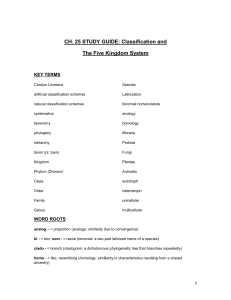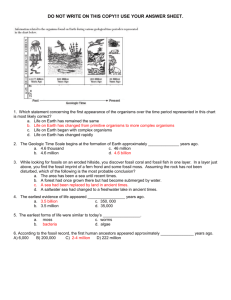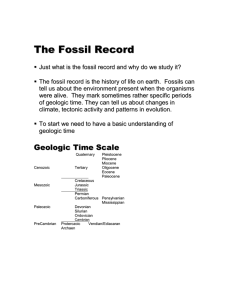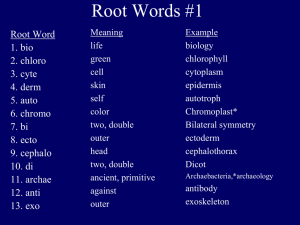BeaulieuetalSupplementREV.
advertisement
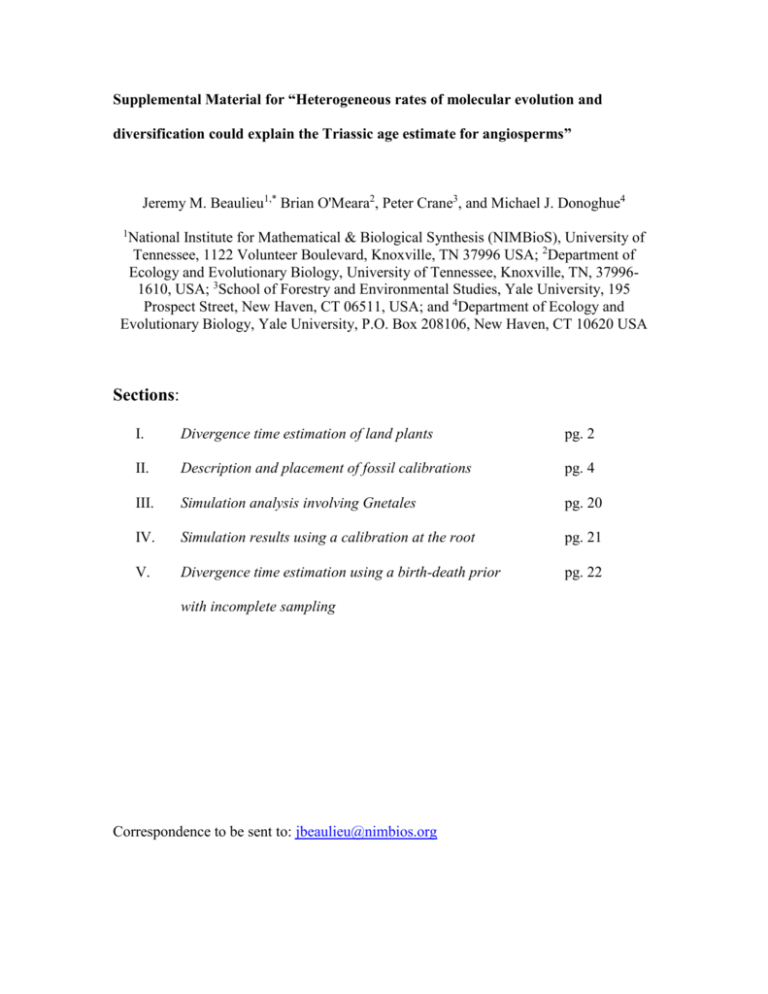
Supplemental Material for “Heterogeneous rates of molecular evolution and diversification could explain the Triassic age estimate for angiosperms” Jeremy M. Beaulieu1,* Brian O'Meara2, Peter Crane3, and Michael J. Donoghue4 1 National Institute for Mathematical & Biological Synthesis (NIMBioS), University of Tennessee, 1122 Volunteer Boulevard, Knoxville, TN 37996 USA; 2Department of Ecology and Evolutionary Biology, University of Tennessee, Knoxville, TN, 379961610, USA; 3School of Forestry and Environmental Studies, Yale University, 195 Prospect Street, New Haven, CT 06511, USA; and 4Department of Ecology and Evolutionary Biology, Yale University, P.O. Box 208106, New Haven, CT 10620 USA Sections: I. Divergence time estimation of land plants pg. 2 II. Description and placement of fossil calibrations pg. 4 III. Simulation analysis involving Gnetales pg. 20 IV. Simulation results using a calibration at the root pg. 21 V. Divergence time estimation using a birth-death prior pg. 22 with incomplete sampling Correspondence to be sent to: jbeaulieu@nimbios.org I. Divergence time estimation of land plants Four highly conserved chloroplast genes were chosen for the dating analysis: 18S, atpB, psbB, and rbcL. These genes were selected because they provide generally good information about relationships among the major clades of land plants (Soltis et al. 2002; Pryer et al., 2001; Magallón 2010; Smith et al. 2010). Taxonomic sampling included all the major lineages of the Tracheophyta: 91 taxa from Angiospermae, 20 from Acrogymnospermae, seven from Monilophyta, and one from Lycopodiophyta, all sensu Cantino et al. (2007). A single taxon from Marchantiophyta (Marchantia) was included as an outgroup. The use of several outgroups to seed plants allowed inferences about the timing of angiosperm origin in the context of land plant diversification as a whole. Sampling within Angiospermae includes every major “order” of flowering plants, with expanded sampling for the Nymphaeales, Austrobaileyales, and Magnoliidae to allow for a more precise placement of several fossil calibrations. Representative sampling for the four other lineages of acrogymnosperms included every major “family” of Coniferae, Gnetophyta, and Cycadophyta. Sequences for each gene region were aligned separately with MAFFT (Katoh et al. 2002) within five partitions: angiosperms, acrogymnosperms, monilophytes, lycopodophytes, and Marchantia. These separate alignments were then combined using profile alignment techniques (Edgar 2004; Smith et al. 2009), and the aligned gene regions were concatenated using phyutility (Smith and Dunn 2008). Dating analyses were conducted using Markov chain Monte Carlo (MCMC) methods implemented in BEAST (Ver. 1.75; Drummond et al. 2006; Drummond and Rambaut 2007). BEAST allows for uncertainty in divergence time estimation by simultaneously incorporating uncertainty in both tree topology and the age of multiple fossil calibrations. Age estimates for fossil calibrations were treated as probabilistic priors, rather than point estimates. The marginal posterior distributions of land plant divergence times were inferred using an uncorrelated lognormal model (UCLN). Both the GTR+Γ nucleotide substitution model and the UCLN clock model were partitioned by gene. We also assumed a birth-death branching prior for branching rates in the phylogeny. The topology was fixed to reflect the most current understanding of relationships among land plants (Stevens 2012). This fixed topology was generated from a maximum likelihood analysis of the data using RAxML (Stamatakis 2006) with branch lengths smoothed to time in r8s (Sanderson 2002). Three independent MCMC runs of 40 million generations were carried out, with the first 10 million generations discarded as burn-in for each run. Post burn-in samples from the marginal posterior distribution were combined using LogCombiner v1.7.5 (Drummond and Rambaut 2007). Trees were summarized with TreeAnnotator v1.7.5 and the results represent the maximum clade credibility trees with the consensus ages being the median estimate. References Cantino P.D., Doyle J.A., Graham S.W., Judd W.S., Olmstead R.G., Soltis D.E., Soltis P.S., Donoghue M.J. 2007. Towards a phylogenetic nomenclature of Tracheophyta. Taxon 56: 822-846. Drummond A.J., Ho S.Y.W., Phillips M.J., Rambaut A. 2006. Relaxed phylogenetics and dating with confidence. PLoS Biology 4: e88. Drummond A.J., Rambaut A. 2007. Bayesian evolutionary analysis by sampling trees. BMC Evolutionary Biology 7: 214. Edgar R.C. 2003. MUSCLE: multiple sequence alignment with high accuracy and high throughput. Nucleic Acids Research, 33: 511-518. Magallón S. 2010. Using fossils to break long branches in the molecular dating: A comparison of relaxed clocks applied to the origin of angiosperms. Systematic Biology 59: 384-399. Katoh K., Misawa K., Kuma K., Miyata T. 2002. MAFFT: a novel method for rapid multiple sequence alignment based on fast Fourier transform. Nucleic Acids Research 14: 3059-3066. Pryer K.M., Schneider H., Smit A.R., Cranfill R., Wolf P.G., Hunt J.S., Sipes S.D. 2001. Horsetails and ferns are a monophyletic group and the closest living relatives to seed plants. Nature 409: 618-622. Sanderson M.J. 2002. Estimating absolute rates of molecular evolution and divergence times: a penalized likelihood approach. Molecular Biology and Evolution 14: 1218-1231. Smith S.A., Beaulieu J.M., Donoghue M.J. 2009. Mega-phylogeny approach for comparative biology: an alternative to supertree and supermatrix approaches. BMC Evolutionary Biology 9: 1-12. Smith, S. A., Beaulieu J.M, Donoghue M.J. 2010. An uncorrelated relaxed-clock analysis suggests an earlier origin for flowering plants. Proceedings of the National Academy of Sciences 107: 5897-5902 Smith S.A., Dunn C.W. 2008. Phyutility: a phyloinformatics tool for trees, alignments and molecular data. Bioinformatics 24: 715-716. Soltis P.S., Soltis D.E., Savolainen V., Crane P.R., Barraclough T.G. 2002. Rate heterogeneity among lineages of tracheophytes: Integration of molecular and fossil data and evidence for molecular living fossils. Proceedings of the National Academy of Sciences 99: 4430-4435. Stamatakis A. 2006. Maximum likelihood-based phylogenetic analyses with thousands of taxa and mixed models. Bioinformatics 22: 2688-2690. Stevens, P. F. (2001 onwards). Angiosperm Phylogeny Website. Version 12, July 2012 [and more or less continuously updated since]. II. Description and placement of fossil calibrations Since the publication of recent studies dating angiosperm origins and diversification based on molecular data (Smith et al. 2010; Magallón 2010; Bell et al. 2010; Clark et al. 2011), several additional calibration points have been suggested among early-branching angiosperm lineages (Doyle and Endress 2010). These hypotheses place several fossil flowers from the Early Cretaceous into currently accepted angiosperm relationships. Of particular interest are ideas regarding the phylogenetic position of fossil Nymphaeales, Austrobaileyales, and Chloranthales. Notwithstanding the assumptions and uncertainties inherent in these hypotheses, for present purposes, we added these new calibrations to a set of key fossil calibrations selected from the 33 used by Smith et al. (2010). Brief summaries of the fossils used as calibration points are provided below. Numbers correspond to those in Figure S1, which show the placement of these fossils. 1. Caryanthus triasseris Fossil type: Flower Source: Knobloch and Mai (1983) Locality/Stratigraphy: Peruc-sequence Bohemia, Czech Republic Age: late Cenomanian 93.6 Ma Node: crown Fagales Discussion: Caryanthus triasseris is the earliest known fossil flower of the Normapolles group, although probable Normapolles pollen occurs slightly earlier in the middle Cenomanian (Friis et al. 2011). Caryanthus flowers are common in Late Cretaceous fossil floras from Europe. Flowers are bisexual and subtended by a small bract and two lateral bracteoles. Flowers are epigynous with four tepals, six to eight stamens, and an inferior, bicarpellate, unilocular ovary with two styles. Pollen is similar to dispersed Normapolles pollen that has been assigned to the genus Plicapollis. Comparison of floral characters of Caryanthus and other Normapolles flowers with extant taxa suggests complex relationships to families of core Fagales (Friis et al. 2006; Friis et al. 2011). Caryanthus is especially similar to extant Rhoipteleaceae (Friis et al. 2011). Conservative interpretation of the fossil record of Caryanthus and other Normapolles fossil suggests that crown core Fagales were in existence by the late Cenomanian. 2. Esgueiria sp. Fossil type: Flower Source: Takahashi et al. (1999) Locality/Stratigraphy: Kamikitaba locality, Ashizawa Formation, Fukushima Prefecture, northeastern Japan Age: Early Coniacian 89.3 Ma Node: Combretaceae-Rest of Myrtales split. Discussion: Esgueiria is an extinct genus based on flowers, fruits, and inflorescence fragments that were first described from two localities (Esgueira, Mira) the Late Cretaceous of Portugal (Friis et al. 1992). Flowers are bisexual and epigynous, with five petals, a basically pentamerous androecium, and a trilocular inferior ovary with three free styles. Older material (early Coniacian) has been described subsequently from Japan (Takahashi et al. 1999). Relationships of Esguieria are clearly with Myrtales and especially with extant Combretaceae (Friis et al. 1992, 2011). Esgueiria may be on the Combretaceaae stem (Friis et al. 2011) 3. Ilexpollenites sp. Fossil type: Pollen Source: Martin (1977) Locality/Stratigraphy: Clarifera triplex zone southeastern Australia Age: Turonian 89.3 Ma Node: Ilex-rest of the Aquifoliaceae Discussion: Dispersed Ilex-like pollen, typically assigned to the form genus Ilexpollenites is common the Cenozoic (Muller 1981). Pollen is prolate to oblate and tricolporate with poorly defined pores. Especially distinctive is the ornamentation of the pollen wall with conspicuous gemmae and clavae of variable sizes (Martin 1977). Muller (1981) notes that the earliest records of Ilexpollenites are from the Turonian and Coniacian of Australia, and this is confirmed by observations by Martin and Partridge from the Clarifera triplex zone in southeastern Australia (unpublished, Martin pers. comm.) 4. Hironoia fusiformis Fossil type: Fruit Source: Takahashi et al. (2002) Locality/Stratigraphy: Kamikitaba locality, Ashizawa Formation, Fukushima Prefecture, northeastern Japan Age: Early Coniacian 89.3 Ma Node: crown Cornales Discussion: Fruits of Hironoia fusiformis comprise the earliest unequivocal record for the Cornales. Fruits are fusiform in shape and develop from an epigynous flower with four to six tepals. Each fruit has three to four locules, each which contains a single seed that is shed through a distinctive dorsal germination valve. These features of Hironoia indicate an unequivocal relationship to the Nyssa and Mastixia lineages of extant Cornales. 5. Friisicarpus brookensis (pistillate inflorescences), Aquia brookensis (staminate inflorescences), and Sapindopsis (leaves). Fossil type: Flowers, inflorescences and leaves Source: Crane et al. (1993) Locality/Stratigraphy: Potomac Group, “Bank near Brooke”, Virginia, USA Age: middle Albian 105.8 Ma Node: Platanaceae-Nelumbonaceae split Discussion: Pinnatifid leaves in the Early to Middle Albian of the Potomac Group are among the earliest occurrences of Sapindopsis leaves. Leaf architecture (Hickey and Doyle 1977) and cuticle (Upchurch 1984) both imply a relationship between Sapindopsis and the platanoid leaves that are common in many Albian floras. Several lines of evidence suggest that Friisicarpus brookensis (formerly Platanocarpus brookensis; Maslova and Herman 2006) and Aquia brookensis are the reproductive structures of Sapindopsis. Pollen grains found in situ within A. brookensis are found on the distal portions of F. brookensis carpels, and the cuticular structure of the leaves and tepals of F. brookensis is similar to that of the cuticle of Sapindopsis. Doyle and Endress (2010) follow Crane et al. (1993) in treating F. brookensis, A. brookensis and Sapindopsis as a single species, and analyzed its relationships to extant Platanus and another Early Cretaceous (Late Albian) platanoid (“the West Brothers platanoid”). The most parsimonious arrangement either placed Sapindopsis as basal to a clade comprised of the “West Brothers platanoid” and extant Platanus, or placed Sapindopsis and the “West Brothers platanoid” as a clade, which was then sister to Platanus. Synapomorphies that link these fossils to extant Platanus include the infructescence heads, sessile flowers, polymerous perianth, and H-valvate anther deshiscence (Doyle and Endress 2010). 6. Tricolpate pollen grains Fossil type: Stems with attached leaves and flowers preserved at fruiting stage. Source: Leng and Friis (2003, 2006). Locality/Stratigraphy: Yixian Formation, Dawangzhangzi Villeage, western Liaoning, China Age: Barremian-Aptian 125 Ma Node: crown Eudicotyledonae Discussion: The first appearance of tricolpate pollen in the Late Barremian-Early Aptian (~125.0 Ma) is generally taken as the first record of stem Eudicotyledonae (Friis et al. 2011: eudicots; Cantino et al. 2007). The most securely dated record is from Phase 4 of the Wealden sequence in the UK (latest Barremian; Hughes and McDougall 1990; Hughes 1994), but there are also scattered reports of tricolpate grains of approximately the same age from northern and equatorial Africa, as well as North America (Doyle 1992; Brenner 1996). There are several putative eudicot macrofossil reproductive structures that could be Early Aptian in age (e.g., Sinocarpus; Leng and Friis 2003, 2006; Leefructus Sun et al. 2011). There are also leaves of similar age (Potomacapnos Jud and Hickey 2013) that have been attributed to crown eudicots. Unequivocal early eudicot flowers are known from slightly younger deposits that are of Late Aptian-Early Albian age (Friis et al. 2011). 7. Typha sp. Fossil type: Inflorescence Source: Grande (2013) Locality/Stratigraphy: Age: Eocene 40.4 Ma Node: Typha-Sparganium split Discussion: The fossil record of Typhaceae-Sparganiaceae is well documented from the Eocene onwards. Infructescences similar to those of Sparganium are known from the Eocene Golden Valley Formation of North Dakota (Hickey 1977) and a single distinctive infructescence of Typha is know from the Eocene, Green River Formation of Wyoming (Grande 2013). Typha-like seeds (Typhaspermum) have been reported from the latest Eocene to early Oligocene of Australia (Dettmann and Clifford 2000). Subsequently, from about the Eocene-Oligocene boundary onwards, dispersed fruits of Typha are abundant (Collinson 1988). 8. Sabal magothiensis Fossil type: Leaves Source: Berry (1911); Daghlian (1981) Locality/Stratigraphy: Magothy Formation, New Jersey, USA. Age: Late Coniacian-Early Santonian 85.8 Ma Node: crown Arecales Discussion: Leaves of Sabal magothiensis are the first unequivocal occurrence of palms in the fossil record. The leaves are costa-palmately compound and are superficially similar to the leaves of the modern genus Sabal. Putative palm pollen also appears in the fossil record at about the same time (Friis et al. 2011). 9. Mayoa portugalica Fossil type: Pollen Source: Friis et al. 2004 Locality/Stratigraphy: Almargem Formation, northeast Torres Vedras, Portugal Age: Barremian-Aptian 125 Ma Node: crown Araceae Discussion: Pollen of Mayoa portugalica, described from the Barremian-Early Aptian of Portugal (Friis et al. 2004), is inaperturate with a distinctly striate surface that is composed of uniform, straight, and closely spaced ribs separated by narrow grooves. The two sets of ribs on the different sides of the pollen grain run somewhat perpendicular to one another, and each covers approximately half the grain. The grains are most similar to those of some extant Araceae in the subfamilies Monsteroideae and Aroideae, but are especially similar to pollen of extant Holochlamys beccarii. We treat Mayoa conservatively as the first unequivocal fossil occurrence of Araceae in the Cretaceous. There are also unequivocal aroid inflorescences from the Late Aptian– Early Albian of Portugal (Friis et al. 2010) 10. Walkeripollis gabonensis Fossil type: Pollen Source: Doyle et al. (1990a, b) Locality/Stratigraphy: Elf-Aquitaine Well TM.1, near N’Toum in northern Gabon. Age: Barremian-Aptian 125 Ma Node: Winteraceae-Canellaceae split Discussion: Pollen of the Walkeripollis type has long been assigned to the extant angiosperm family Winteraceae, which also produce reticulate, monoporate grains that adhere together in tetrads (Walker et al. 1983). Both Walkeripollis and tetrads of extant Winteraceae have an annulate ulcus bordered by a ring of darker endexine (Doyle et al. 1990a,b). Doyle and Endress (2010) find that the most parsimonious position of W. gabonensis (with only weak support) is sister to extant Winteraceae. However, the analysis is limited by the small number of characters available (Doyle and Endress 2010). Nevertheless these distinctive grains are clearly more closely related to extant Winteraceae than to any other extant group. 11. Mauldinia mirabilis Fossil type: Flowers and inflorescences Source: Drinnan et al. (1990) Locality/Stratigraphy: Elk Neck Beds, Mauldin Mountain, Maryland, USA Age: Late Cenomanian 99.6 Ma Node: Monimiaceae-Lauraceae+Hernandiaceae split Discussion: Mauldinia mirabilis is known from well-preserved inflorescences and bisexual flowers. Flowers are trimerous with two trimerous whorls of tepals. The androecium is also trimerous with three whorls of stamens and a whorl of staminodes. The gynoecium is unicarpellate. Mauldinia was originally assigned to Lauraceae based on the strong similarities to flowers of extant Lauraceae, including the details of stamens and their associated glands. However, phylogenetic analysis suggests that M. mirabilis may be the sister group to both Lauraceae and Hernandiaceae (Doyle and Endress 2010). However, a complicating factor is that the relationship between Lauraceae and Hernandiaceae is not well supported by molecular data (Renner 2005; Soltis et al. 2011), with Monimiaceae, rather than Hernandiaceae often supported as the sister group to Lauraceae, raising the question of whether Mauldinia may be better placed as sister to a clade comprised of Hernandiaceae-Lauraceae-Monimiaceae. Here we treat Mauldinia conservatively as a providing a mimimum age for the divergence of Monimiaceae from Lauraceae+Hernandiaceae. 12. Virginianthus calycanthoides Fossil type: Flower Source: Friis et al. (1994) Locality/Stratigraphy: Puddledock locality, Potomac Group, Virginia, USA. Age: Early –Middle Albian 105.8 Ma Node: Calycanthaceae-rest of Laurales Discussion: Virginianthus calycanthoides is known from a single flower that has numerous helically arranged tepals, stamens, inner staminodes on the rim of a deep hypanthium that surrounds the carpels. Based on these features Friis et al. (1994) assigned Virginianthus to Calycanthaceae, the earliest diverging lineage within the Laurales. Doyle and Endress (2010) and Friis et al. (2011) place V. calycanthoides as a probable stem relative of extant Calycanthaceae. Here we use V. calycanthoides to provide a minimum age for the origin of Laurales. 13. Endressinia brasiliana Fossil type: A shoot bearing several flowers and leaves Source: Mohr and Bernardes-de-Oliveira (2004) Locality/Stratigraphy: Crato formation, Araripe Basin, Nova Olinda, Brazil Age: Late Aptian 114 Ma Node: Magnoliaceae-Annonaceae+Degeneriaceae+Eupomatiaceae+Himantandraceae Discussion: Endressinia brasiliana from the Late Albian of Brazil has been assigned to Magnoliales based on a suite of features, including the presence of oil glands in the leaves and floral parts, alternate leaves, solitary flowers, broad tepals and apocarpous gynoecium consisting of many plicate carpels. Especially distinctive is the multiparted androecium with inner staminodes bearing stalked multicellular structures along their margins (Mohr and Bernardes-de-Oliveira 2004). This initial assignment is consistent with the results of Doyle and Endress (2010) who suggest that the presence of glands on the staminodes favors a placement along the branch leading to AnnonaceaeDegeneriaceae-Eupomatiaceae-Himantandraceae. 14. Anacostia teixeirae Fossil type: Fruits and seeds Source: Friis et al. (1997) Locality/Stratigraphy: Vale de Agua, Portugal Age: Barremian-Aptian 125 Ma Node: Trimeniaceae-Schisandraceae split Discussion: Anacostia is based on small, unilocular, single seeded fruiting units that are sometimes borne in cone-like structures (Friis et al. 1997, 2011). Initial studies suggested an affinity with both Canellaceae and Schisandraceae (including Illicium), which at that time were considered a monophyletic group (see Donoghue and Doyle 1989). However, there is now clear molecular evidence that Canellaceae and Schisandraceae are not closely related, making exact placement of this fossil unclear. Recent analyses (Doyle and Endress 2010; Friis et al. 2011) suggest that Anacostia may be sister to Schisandraceae (including Illicium). Although the pollen is very different, the cone-like structures of Anacostia teixeirae resemble the aggregated or elongated heads of baccate fruitlets that occur in extant Schisandraceae. 15. Archaefructus liaoningensis Fossil type: Axes with attached leaves and flowers Source: Sun et al. (2002) Locality/Stratigraphy: Yixian formation, Beipiao and Lingyuan, western Liaoning, China Age: Barremian-Aptian 125 Ma Node: Hydatellaceae-Nymphaeaceae+Cabombaceae Discussion: Archaefructus was described originally (Sun et al. 2002) as a member of a new angiosperm family, Archaefructaceae, thought to be the sister group to all other angiosperms. Archaefructus was interpreted as a small, herbaceous, and branched aquatic plant with axillary shoots bearing strongly dissected leaves and terminal reproductive structures. Reproductive axes were interpreted as a solitary flowers without a perianth, with stamens borne in pairs on short helically arranged stalks, and with numerous carpels borne helically or in whorls (Sun et al. 2002). The interpretation of the reproductive axes as a single flower was based solely on the absence of bracts and/or bract scars below the individual organs. Friis et al. (2003) noted that there are extant examples of taxa with flowers that lack subtending bracts, and that paired carpels and stamens are unknown in multiparted angiosperm flowers. Reproductive axes of Archaefructus are more likely to be inflorescences consisting of unisexual flowers, with staminate flowers near the base and pistillate flowers distally. Interpreted in this way, current phylogenetic hypotheses suggest a sister relationship to Hydatellaceae (Endress and Doyle 2009; Doyle and Endress 2010). 16. Palaeotaxus rediviva Fossil type: Seed-bearing leafy shoots Source: Florin (1958) Locality/Stratigraphy: Upper coal bed, Skromberga Colliery, Scania, Sweden Age: earliest Jurassic 197 Ma Node: Taxaceae–Cupressaceae split. Discussion: Palaeotaxus rediviva is known from leafy shoots bearing spirally arranged, bifacially flattened leaves with a single midvein. The leaves are twisted during growth into distichous rows. Some axillary short shoots have sterile scales and terminate in a single ovule that is surrounded by an aril. As in Austrotaxus and Taxus the scales are helically arranged (in Amentotaxus and Torreya they are decussate). Florin hesitated to include Paleotaxus in extant Taxaceae because of differences in cuticular morphology. However, Paleotaxus provides a minimum age for the divergence between Taxaceae (including Cephalotaxus) and Cupressaceae sensu lato. Molecular data suggest that Cephalotaxus is nested among genera traditionally included in Taxaceae, either as sister to a Torreya-Amentotaxus clade or sister to the Taxus clade (Hao et al. 2008). 17. Araucarites rudicula Fossil type: Cone Source: Axsmith and Ash (2006) Locality/Stratigraphy: Chinle Formation, Arizona, US Age: late Triassic 213 Ma Node: Podocarpaceae-Araucariaceae split Discussion: Araucarites rudicula is known from a cone with attached cone scales, but that is not attached to a leafy shoot. The cone scale has a markedly constricted base unlike any living Araucariaceae, and unlike other fossil Araucariaceae does not appear to have a ligule. The cone scale is interpreted as completely fused to the bract, as in modern Agathis or Wollemia. Assignment of Araucarites rudicula to Araucariaceae is based on its single ovule and its reduced, presumably fused, ovule scale. Divergence of the Araucariaceae by the Late Triassic is also supported by the abundance of Araucaria-like wood, foliage and pollen, although none of these fossils are unequivocally diagnostic of the family. 18. Cratonia cotyledon Fossil type: Cotyledons Source: Rydin et al. (2003) Locality/Stratigraphy: Crato formation, Araripe Basin, Brazil Age: late Aptian 114 Ma Node: Welwitschiaceae-Gnetaceae split Discussion: Cratonia cotyledon is a fossil seedling with two large ovate cotyledons that exhibit distinctive “Y” venation similar to that seen in the cotyledons of extant Welwitschia. There is also a lateral “feeder” arising from the hypocotyl region perpendicular to the axis of the plant. The presence of a “feeder” is characteristic of seedlings of extant Gnetum and Welwitschia. The “Y” venation suggests that C. cotyledon is more closely related to Welwitschia rather than to Gnetum. Cratonia suggests that the split between Welwitschiaceae and Gnetaceae occurred by at least the Late Aptian. 19. Primocycas chinensis Fossil type: Megasporophyll Source: Zhu and Du (1981) Locality/Stratigraphy: Lower Shihezi formation, Shanxi, China Age: Permian 270 Ma Node: Cycadaceae-Zamiaceae split Discussion: Primocycas chinensis is known from a palmate megasporophyll that bears two rows of ovules borne on the proximal portion of the stalk. The form of this megasporophyll is similar to that of extant Cycas, which is the sister genus to all other extant cycads. We treat this fossil conservatively providing a minimum age for the split between Cycadaceae and Zamiaceae. 20. Stachypteris spicans Source: Harris (1961) Locality/Stratigraphy: Yorkshire Beds, Lower Deltaic Series Age: Middle Jurassic, Bajocian 172-168 Ma Node: Lygodium–rest of the Schizaeaceae Discussion: Stachypteris spicans is a fern with a distinctive fertile “spike”. Resin transfers suggest that Stachypteris spicans has an arrangement of sporangia similar to the situation in Lygodium in there are two rows of individual sporangia on each fertile pinnule, and each sporangium is borne between the fertile pinnule lamina and a small flap of indusium-like laminar tissue. The whole structure is strobilus-like (“fertile spike”). Such a spike-like arrangement is unique to Lygodium among the schizeoid ferns and among ferns more generally. 21. Pekinopteris auriculata Source: Axsmith and Skog (2009) Locality/Stratigraphy: Pekin Formation, North Carolina Age: Upper Triassic, Carnian 235-228 Ma Node: Schizaeoids–Core Leptosporangiates split Discussion: Pekinopteris auriculata is known from leaves with attached sporangia that are not born in sori. Sporangia have an apical annulus, which is common among extant schizaeoid ferns, but not diagnostic. Among other fossils, Klukia exilis (Harris 1961) from the Middle Jurassic of Yorkshire, U.K. (Bajocian, 172-168 Ma) also produces schizaeoid spores and the characteristic reproductive features: apical annulus, lack of sori, fertile pinnules. 22. Palaeosmunda sp. Source: Gould (1970) Locality/Stratigraphy: Burngrove Formation, Rangal Coal Measures, Bowen Basin Coal Measures, Queensland, Australia Age: latest Permian 251 Ma Node: Osmundaceae–rest of the leptosporangiates Discussion: The stelar anatomy of the species of fern stem assigned to Palaeosmunda from the Bowen Basin of Queensland strongly suggests they are osmundaceous. They have an ectophloic siphonostele with large leaf gaps and C-shaped leaf traces. The leaf traces have thickened cortical sclerenchyma and the petioles are clustered around the stem axis in a mantle. These features are all seen in extant Osmundaceae. Stems of Osmundaceae are also reported from the Upper Permian of Russia, although the exact stratigraphy is not usually reported in the second-hand sources. These stems appear to be uniformly protostelic and lack leaf gaps. While they could very well be Osmundaceous, Palaeosmunda is much more similar to extant species. Bowen Basin Coals are generally considered Permian in age, and the Rangal Coal Measures are considered Late Permian. 23. Rellimia thomsonii Source: Dannenhoffer and Bonamo (1989) Locality/Stratigraphy: Panther Mountain Formation, New York State, U.S.A. Age: Middle Givetian 388 Ma Node: Spermatophyta–Monilophyta split Discussion: Rellimia the earliest known progymnosperm, is first recorded in the early Eifelian (Beck 1976), although the younger specimens from the Givetian are more informative. Rellimia, and progymnosperms in general, possess a bifacial cambium that produced both secondary xylem and secondary phloem, a feature that unites progymnosperms and extant seed plants (i.e., the lignophyte clade) to the exclusion of all other groups of vascular plants. Rellimia therefore provides a minimum age for the split between seed plants and extant monilophytes. 24. Baragwanathia longifolia Fossil type: Axes with microphylls and sporangia Source: Lang and Cookson (1935); Garratt (1978) Locality/Stratigraphy: Dargile/Yea formations, Victoria, Australia Age: Silurian (Ludlow) 423 Ma Node: Lycopodiophyta-Monilophyta+Spermatophyta split Discussion: Baragwanathia longifolia is known from branching axes bearing long narrow parallel-sided microphylls. Reniform sporangia are also borne on the axes interspersed among the microphylls. A close relationship between Baragwanathia and modern homosporous lycopods has long been recognized (Lang and Cookson, 1935; Kenrick and Crane 1997a,b). Formal cladistic analysis resolves Baragwanathia on the stem group to all extant homosporous and heterosporous lycopods. There has been much debate regarding the exact age of Baragwanathia (Hueber, 1983; Garratt et al. 1984). The Ludlow age used here reflects the identification of associated graptolites (Monograptus unicinatus), which are restricted to the Gorstian stage of the Ludlow in the Silurian (see Rickards 2000 for detailed discussion). References Axsmith B. J., Ash S. R. 2006. Two rare fossil cones from the Upper Triassic Chinle Formation in Petrified Forest National Park, Arizona, and New Mexico. Museum of Northern Arizona Bulletin 62: 82-94. Axsmith B.J., Skog J.E. 2009. A Triassic mystery solved – fertile Pekinopteris auriculata. Botanical Society of America 002-98. Beck C.B. 1976. Current status of the progymnospermopsida. Review of Palaeobotany and Palynology 21: 5-23. Bell C.D., Soltis D.E., Soltis P.S. 2010. The age and diversification of the angiosperms revisited. American Journal of Botany 97: 1296-1303 Brenner G.J. 1996. Evidence for the earliest stage of angiosperm pollen evolution: A paleoequatorial section from Israel. In: D.W. Taylor, L.J. Hickey, editors. Flowering Plant Origin, Evolution, and Phylogeny. New York: Chapman and Hall. p. 91-115. Berry E. W. 1911. Contributions to the Mesozoic flora of the Atlantic Coastal Plain VII. Bulletin of the Torrey Botanical Club 38: 399-424. Cantino, P.D., Doyle J.A., Graham S.W., Judd W.S., Olmstead R.G., et al. 2007. Towards a phylogenetic nomenclature of Tracheophyta. Taxon 56: 822-846. Clark J.T., Warnock R.C.M., Donoghue P.J. 2011. Establishing a time-scale for plant evolution. New Phytologist 192: 266-301. Collinson M.E. 1988. Freshwater macrophytes in palaeolimnology. Palaeogeography, Palaeoclimatology, Palaeoecology 62: 317-342. Crane P.R., Pedersen K.R., Friis E.M., Drinnan A.N. 1993. Early Cretaceous (Early to Middle Albian) platanoid inflorescences associated with Sapindopsis leaves from the Potomac group of Eastern North America. Systematic Botany 18: 328-344. Daghlian C.P. 1981. A review of the fossil record of monocotyledons. The Botanical Review 47: 517-555. Dannenhoffer J.M. Bonamo P.M. 1989. Rellimia thomsonii from the Givetian of New York: Secondary growth in three orders of branching. American Journal of Botany 76: 1312-1325. Dettman M.E., Clifford H.T. 2000. Fossil Typha in Australia. Memoirs –Queensland Museum 45: 234-234 Donoghue M.J., Doyle J.A. 1989. Phylogenetic analysis of angiosperms and the relationships of Hamamelidae. In: Evolution, Systematics and Fossil History of Hamamelidae, vol. I., Introduction and “Lower” Hamamelidae (ed. P.R. Crane and S. Blackmore), pp. 17-45, Clarendon Press, Oxford. Doyle, J.A. 1992. Revised palynological correlations of the lower Potomac Group (USA) and the Cocobeach sequence of Gabon (Barremian-Aptian). Cretaceous Research 13:337-349. Doyle J.A., Hotton C.L., Ward J.V. 1990a. Early Cretaceous tetrads, zonasulculate pollen, and Winteraceae. I. Taxonomy, morphology, and ultrastructure. American Journal of Botany 77: 1544-1557. Doyle J.A., Hotton C.L., Ward J.V. 1990b. Early Cretaceous tetrads, zonasulculate pollen, and Winteraceae II. Cladistic analysis and implications. American Journal of Botany 77: 1558-1568. Doyle J.A., Endress P.K. 2010. Integrating Early Cretaceous fossils into the phylogeny of living angiosperms: Magoliidae and eudicots. Journal of Systematics and Evolution 48: 1-35. Drinnan A.N., Crane P.R., Friis E.M., Pedersen K.R. 1990. Lauraceous flowers from the Potomac group (mid-Cretaceous) of Eastern North America. Botanical Gazette 151: 370-384. Drinnan A.N., Crane P.R., Friis E.M., Pedersen K.R. 1991. Angiosperm flowers and tricolpate pollen of buxaceous affinity from the Potomac group (mid-Cretaceous) of eastern North America. American Journal of Botany 78: 153-176. Endress P.K., Doyle J.A. 2009. Reconstructing the ancestral angiosperm flower and its initial specializations. American Journal of Botany 96: 22-66. Florin R. 1958. On Jurassic taxads and conifers from north-western Europe and Eastern Greenland. Acta Horti Bergiani 17: 257-402. Friis E.M., Pedersen K.R., Crane P.R. 1992. Esgueira gen. nov., fossil flowers with combretaceous features from the Late Cretaceous of Portugal. Biol. Skr. 41:1-45. Friis E.M., Eklund H., Pedersen K.R., Crane P.R. 1994. Virginiathus calycanthoides gen. et. Sp. nov. – a calycanthaceous flower from the Potomac Group (Early Cretaceous) of Eastern North America. International Journal of Plant Sciences 155: 772-785. Friis E.M., Crane P.R., Pedersen K.R. 1997. Anacostia, a new basal angiosperm from the Early Cretaceous of North America and Portugal with trichotomocolpate/monocolpate pollen. Grana 36: 225-244 Friis E.M., Doyle J.A., Endress P.K., Leng Q. 2003. Archaefructus – angiosperm precursor or specialized early angiosperm. Trends in Plant Science 8: 369-373. Friis E.M., Pederson K.R., Crane P.R. 2004. Araceae from the Early Cretaceous of Portugal: Evidence on the emergence of monocotyledons. Proceedings of the National Academy of Sciences, USA 101: 16565-16570. Friis E.M., Pedersen K.R., Schonenberger J. 2006. Normapolles plants: a prominent component of the Cretaceous rosid diversification. Plant Systematics and Evolution 260: 107-140. Friis E.M., Pedersen K.R. Crane P.R. 2010. Diversity in obscurity: fossil flowers and the early history of angiosperms. Philosophical Transactions of the Royal Society 365: 369-382. Friis E.M., Crane P.R., Pedersen K.R. 2011. Early Flowers and Angiosperm Evolution. Cambridge University Press, Cambridge Garratt M.J. 1978. New evidence for a Silurian (Ludlow) age for the earliest Baragwanathia flora. Alcheringa 2: 217-224. Garrat M.J., Tims J.D., Rickards R.B., Chambers T.C., Douglas J.G. 1984. The appearance of Baragwanathia (Lycophytina) in the Silurian. Botanical Journal of the Linnean Society 80: 355-358. Gould R.E. 1970. Palaeosmunda, a new genus of siphonostelic osmundaceous trunks from the Upper Permian of Queensland. Palaeontology 13: 10-28. Grande L. 2013. The Lost World of Fossil Lake: Snapshots from Deep Time. Chicago, University of Chicago Press. Hao D.C., Hunag B.L., Yang L. 2008. Phyogentic relainhsup of the genus taxaus inferred from Chlorplas integenic spacrer and nuclar coding DNA> Bilogicla dn Pharmacologicl Bulletin, 31: 260-265. Harris T.M. 1961. The Yorkshire Jurassic Flora. Volume 1. London, British Museum (Natural History). Hickey L.J. 1977. Stratigraphy and Paleobotany of the Golden Valley Formation (early Tertiary) western North Dakota. Geological Society of America Memoir 150: 1296. Hickey L.J., Doyle J.A. 1977. Early Cretaceous fossil evidence for angiosperm evolution. Botanical Review 43: 1-104. Hueber F.M. 1983. A new genus of Baragwanathia from the Sextant Formation (Emsian) northern Ontario, Canada. Botanical Journal of the Linnean Society 86: 57-79. Hughes N.F. 1994. The Enigma of Angiosperm Origins. Cambridge; Cambridge University Press. Hughes N.F., McDougall A.B. 1990. Barremian-Aptian angiospermid pollen records from southern England. Review of Palaeobotany and Palynology 65:145-151. Jud N.A. Hickey L. J. 2013 Potomacapnos apeleutheron gen. et sp. nov., a new Early Cretaceous angiosperm from the Potomac Group and its implications for the evolution of eudicot leaf architecture. American Journal of Botany, 100: 2437– 2449. Kenrick P. and Crane 1997a. The origin and early diversification of plants on land. Nature, 389: 33-39. Kenrick P. and P.R. Crane. 1997b. The Origin and Early Diversification of Land Plants. A Cladistic Study. Smithsonian Series in Comparative Biology. Washington D.C. Smithsonian Institution Press. Knobloch E, Mai D.-H. 1983. Carbonized seeds and fruits from the Cretaceous of Bohemia and Moravia and their stratigraphical significance. Knihovnicka Zemniho plynu a nafty 4: 305-332. Lang W.H., Cookson I.C. 1935. On a flora, including vascular land plants, associated with Monograptus, in rocks of Silurian age, from Victoria, Australia. Philosophical Transactions of the Royal Society of London, B 224: 421-449. Leng Q., Friis, E. M. 2003. Sinocarpus decussatus gen. et sp. nov, a new angiosperm with syncarpous fruits from the Yixian Formation of Northeast China. Plant Systematics and Evolution 241: 77–88. Leng Q., Friis, E. M. 2006. Angiosperm leaves associated with Sinocarpus Leng et Friis infructescences from the Yixian Formation (mid-Early Cretaceous) of NE China. Plant Systematics and Evolution 262: 173–87. Magallón S. 2010. Using fossils to break long branches in molecular dating: A comparison of relaxed clocks applied to the origin of angiosperms. Systematic Biology 59: 384-399. Martin H.A. 1977. The history of Ilex (Aquifoliaceae) with special reference to Australia: Evidence from pollen. Australian Journal of Botany 25: 655-673. Maslova N.P., Herman A.B. 2006. Infructescences of Friisicarpus nom. nov. (Platanaceae) and associated foliage of the platanoid type from the Cenomanian of Western Siberia. Paleontological Journal 40: 109-113. Mohr B.A.R., Bernardes-de-Oliveira M.E.C. 2004. Endressinia brasiliana, a magnolialean angiosperm form the Lower Cretaceous Crato formation (Brazil). International Journal of Plant Sciences 165: 1121-1133. Muller J. 1981. Fossil pollen records of extant angiosperms. The Botanical Review 47: 1142. Renner S.S. 2005. Variation in diversity among Laurales, Early Cretaceous to present. Biologiske Skrifter, Kongelige Danske Videnskabernes Selskab 55: 441-458. Pederson K.R., Lund J.J. 1980. Palynology of the plant-bearing Rhaetian to Hettangian Kap Stewart Formation, Scoresby Sund, East Greenland. Review of Palaeobotany and Palynology 31: 1-69. Rickards R.B. 2000. The age of the earliest club mosses: The Silurian Baragwanathia flora in Victoria, Australia. Geology Magazine. 137: 207-209. Rydin C., Mohr B., Friis E.M. 2002. Cratonia cotyledon gen. et sp. nov.: A unique Cretaceous seedling related to Welwitschia. Proceedings of the Royal Society, London (B, Supp) 270: S29-S32. Smith S.A., Beaulieu J.M., Donoghue M.J. 2010. An uncorrelated relaxed-clock analysis suggests an earlier origin for flowering plants. Proceedings of the National Academy of Sciences, USA 107:5897-5902. Soltis D.E., Smith S.A., Cellinese N., Wurdack K.J., Tank D.C., Brockington S.F., Refulio-Rodriguez N.F., Walker J.B., Moore M.J., Carlsward B.S., Bell C.D., Latvis M., Crawley S., Black C., Diouf D., Xi Z., Rushworth C.A., Gitzendanner M.A., Sytsma K.J., Qiu Y.-L., Hilu K.W., Davis C.C., Sanderson M.J., Beaman R.S., Olmstead R.G., Judd W.S., Donoghue M.J., Soltis P.S. 2011. Angiosperm phylogeny: 17 genes, 640 taxa. American Journal of Botany 98: 704–730. Sun G., Ji Q., Dilcher D.L., Zheng S., Nixon K.C., Wang X. 2002. Archaefructaceae, a new basal angiosperm family. Science 296: 899-904 Sun G., Dilcher D.L., Wang H., Chen Z. 2011. A eudicot from the early Cretaceous of China. Nature 471: 625-628. Takahashi M., Crane P.R., Ando H. 1999. Esguieria futabensis sp. nov; a new angiosperm flower from the Upper Cretaceous (lower Coniacian) of northeastern Japan. Paleontological Research 3: 81-87. Takahashi M., Crane P.R., Manchester S.R. 2002. Hironoia fusiformis gen. et sp. nov; a cornalean fruit from the Kamikitaba locality (Upper Cretaceous; Lower Coniacian) in northeastern Japan. Journal of Plant Research doi:10.1007/s10265002-0062-6. Upchurch G.R. 1984. Cuticle evolution in Early Cretaceous angiosperms from the Potomac Group of Virginia and Maryland. Annals of the Missouri Botanical Garden 71: 522-550. Walker J.W., Brenner G.J., Walker A.G. 1983. Winteraceous pollen in the Lower Cretaceous of Israel: Early evidence of a magnolialean angiosperm family. Science 220: 1273-1275. Zhu J., Du X.-M. 1981. A new cycad – Primocycas chinensis gen. et sp. nov. discovered from the Lower Permian in Shanxi, China and its significance. Acta Botanica Sinica 23: 401-404. TABLE S1. Summary of the minimum age and associated lognormal prior-probability distribution parameters for the fossils used as calibrations in our divergence time analysis of land plants (the mean and sd follows from Smith et al. 2010). The number next to each name corresponds to Figure S1. Fossil 1. Carynathus triasseris 2. Esgueria sp. 3. Ilexpollenites sp. 4. Hironoia fusiformis 5. Platanocarpus bookensis 6. Tricolpate pollen 7. Typhaspermum sp. 8. Sabal magothiensis 9. Mayoa portugalica 10. Walkeripollis gabonensis 11. Mauldinia mirabilis 12. Virginianthus calycanthoides 13. Endressinia brasiliana 14. Anacostia teixerae 15. Archaefructus liaoningensis 16. Paleotaxus jurassica 17. Araucites rudicula 18. Cratonia cotyledon 19. Primocycas chinensis 20. Stachypteris spicans 21. Pekinopteris auriculata 22. Paleosmunda sp. 23. Rellimia thomsonii 24. Baragwanathia longifolia Min. age 93.6 89.3 89.3 89.3 105.8 125.0 40.4 85.8 125.0 125.0 99.6 105.8 114.0 125.0 125.0 197.0 213.0 114.0 270.0 168.0 228.0 251.0 388.0 423.0 Mean (SD) 1.5 (0.5) 1.5 (0.5) 1.5 (0.5) 1.5 (0.5) 1.5 (0.5) 1.5 (0.5) 1.5 (0.5) 1.5 (0.5) 1.5 (0.5) 1.5 (0.5) 1.5 (0.5) 1.5 (0.5) 1.5 (0.5) 1.5 (0.5) 1.5 (0.5) 1.5 (0.5) 1.5 (0.5) 1.5 (0.5) 1.5 (0.5) 1.5 (0.5) 1.5 (0.5) 1.5 (0.5) 2.0 (0.5) 2.0 (0.5) FIGURE S1. A cladogram (right) and a molecular tree (left). The molecular tree shows the raw substitutions per site (top left). The cladogram shows the placement of fossil calibrations used in the divergence time analysis (branch lengths are scaled by diversity). Numbers correspond to the fossil descriptions in II above. Black dots indicate fossils also used by Smith et al. (2010). Red dots indicate hypothesized positions of fossils based onDoyle and Endress (2010). III. Simulations involving Gnetales We simulated data sets under a three-rate scenario to reflect the different rates of molecular evolution among acrogymnosperms, woody angiosperms, and herbaceous angiosperms. We also conducted simulations that involved applying different angiosperm-based molecular rate distributions to Gnetales. The Gnetales are an enigmatic clade nested within acrogymnosperms that seem to exhibit elevated substitution rates relative to the rest of the acrogymnosperms. However, whether rates for Gnetales were drawn from the rate distributions of woody or herbaceous angiosperms it had little affecting on the predicted age of the angiosperm crown. For example, when rates were drawn from the herbaceous angiosperm rate distribution and applied to branches within Gnetales, the average bias was 237.7 Ma (95% CI = 195.5 – 280.4 Ma; Figure S2), very similar to, but slightly less than, the bias of subsuming the Gnetales into the rate distribution of all acrogymnosperms. Similarly, when rates for branches within Gnetales were drawn from the woody angiosperm rate distribution, the age remained 237.8 Ma (95% CI = 203.3 – 275.14 Ma; Figure S2). FIGURE S2. Simulation results for the three-rate scenarios that involved applying the herbaceous angiosperm (top) and woody angiosperm rates distributions to Gnetales (bottom). The biases under these simulation scenarios were very similar to the bias of subsuming the Gnetales into the rate distribution of all acrogymnosperms (see Figure 4 in the main text). IV. Simulation results using a calibration at the root We conducted a complimentary analysis to the set described in the main text, where we applied a calibration to the root of the seed plant phylogeny. The minimum age for crown seed plants was set to 317.0 Ma, based on results of our r8s smoothing, and we attached a lognormal prior with a mean 1.5 and a standard deviation of 0.5. The simulations were then run as described in the main text. Results from these simulations are broadly consistent with results that did not include the calibration for crown seed plants, although the mean of the distributions were slightly younger in most cases (Table S2). TABLE S2. Summary of simulation results that included calibration for the root of seed plants. The lower and upper represent the 2.5% and 97.5% quantiles, respectively. Simulation scenario 3:1 herbaceous to woody 6:1 herbaceous to woody 4:1 angio. to gymno.; 3:1 herbaceous to woody angio. 4:1 angio. to gymno.; 3:1 herbaceous to woody angio.; Gnetales herbaceous angio. 4:1 angio. to gymno.; 3:1 herbaceous to woody angio.; Gnetales woody angio. Mean (SD) 207.9 (15.1) 244.5 (20.4) 235.7 (16.0) Lower 184.3 205.1 210.6 Upper 242.9 283.7 267.5 229.7 (17.7) 192.5 260.6 233.1 (16.4) 198.3 261.4 V. Divergence time estimation using a birth-death prior with incomplete sampling As a complimentary analysis to the land plant divergence time analysis discussed in the main text, we applied a birth-death prior that assumes incomplete sampling. With this approach, the normal birth-death parameters are estimated using a third variable, , that scales the birth and death estimates to compensate for the sampling fraction (see Gernhard 2008). However, as Figure S3 shows, applying this prior assumption does little to impact the estimated age of angiosperms. References Gernhard T. 2008. The conditioned reconstructed process. Journal of Theoretical Biology 253:769-778. FIGURE S3. Divergence time estimates for land plants using the UCLN and a birth-death prior that assumes incomplete sampling. The age of angiosperms is identical to the ages inferred using a normal birth-death prior (see Figure 1 in the main text).
